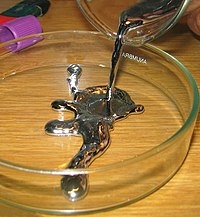
Photo from wikipedia
Three-dimensional (3D) printers are known to emit aerosols, but questions remain about their composition and the fundamental processes driving emissions. The objective of this work was to characterize the aerosol… Click to show full abstract
Three-dimensional (3D) printers are known to emit aerosols, but questions remain about their composition and the fundamental processes driving emissions. The objective of this work was to characterize the aerosol emissions from the operation of a fuse-deposition modeling 3D printer. We modeled the time- and size-resolved emissions of submicrometer aerosols from the printer in a chamber study, gained insight into the chemical composition of emitted aerosols using Raman spectroscopy, and measured the potential for exposure to the aerosols generated by 3D printers under real-use conditions in a variety of indoor environments. The average aerosol emission rates ranged from ∼108 to ∼1011 particles min-1, and the rates varied over the course of a print job. Acrylonitrile butadiene styrene (ABS) filaments generated the largest number of aerosols, and wood-infused polylactic acid (PLA) filaments generated the smallest amount. The emission factors ranged from 6 × 108 to 6 × 1011 per gram of printed part, depending on the type of filament used. For ABS, the Raman spectra of the filament and the printed part were indistinguishable, while the aerosol spectra lacked important peaks corresponding to styrene and acrylonitrile, which are both present in ABS. This observation suggests that aerosols are not a result of volatilization and subsequent nucleation of ABS or direct release of ABS aerosols.
Journal Title: Environmental science & technology
Year Published: 2017
Link to full text (if available)
Share on Social Media: Sign Up to like & get
recommendations!